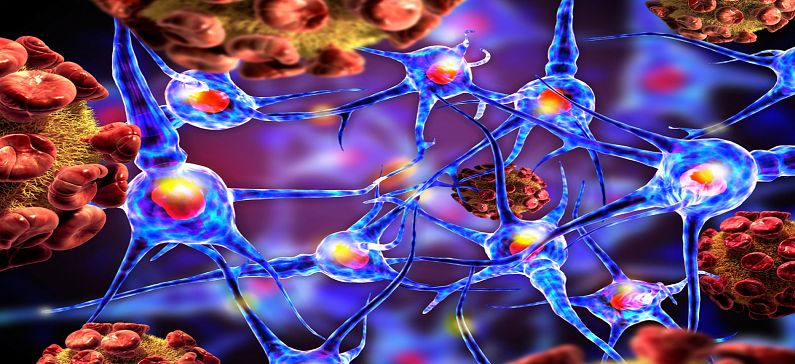
Greek researcher sheds light in Parkinson’s mechanism in the brain
Researchers led by a Greek scientist, may be closer to unraveling the underlying causes of Parkinson’s disease, after identifying the point at which alpha-synuclein – a protein believed to play a key role in the condition – becomes toxic to the brain.
First author Dr. Dorothea Pinotsi, of the Department of Chemical Engineering & Biotechnology and the Department of Chemistry at the University of Cambridge, UK, and colleagues publish their findings in the Proceedings of the National Academy of Sciences.
Parkinson’s disease is a chronic, progressive movement disorder believed to be triggered by the death of nerve cells, or neurons, mainly within a brain region called the substantia nigra – an area key for movement control.
Exactly what causes the death of neurons in Parkinson’s is unclear, but researchers speculate that one cause is abnormal aggregates of alpha-synuclein protein that form inside nerve cells, also known as Lewy bodies. These are considered a hallmark of Parkinson’s.
The researchers explain that Lewy bodies arise as a result of alpha-synuclein folding into the wrong shape, causing them to stick to other proteins. This leads to the development of thin filament-like structures known as alpha-synuclein fibrils.
But according to Dr. Pinotsi, whether alpha-synuclein fibrils are still toxic to nerve cells once they have formed has been unclear.
With a view to finding out, the team used optical “super-resolution” techniques on live neurons of rats, which allowed them to assess how the neurons responded to different forms of alpha-synuclein, without damaging the nerve tissue.
When alpha-synuclein fibrils were introduced to the neurons, they connected with the alpha-synuclein protein that was already in the cell, which produced no toxic effect.
However, the researchers found that adding a soluble form of alpha-synuclein to the neurons did not interact with the pre-existing protein in the cell, and this caused the nerve cells to die.
“So somehow, when the soluble protein was added, it created this toxic effect. The damage appears to be done before visible fibrils are even formed,” explains Dr. Pinotsi.
Next, the researchers introduced both the soluble form of alpha-synuclein and the alpha-synuclein fibrils to the neurons. They found that this combination overcame the toxic effects caused by the soluble alpha-synuclein; the fibrils attracted the soluble proteins like magnets, according to the team, cleaning them up and hampering their toxicity.
Commenting on their results, Dr. Pinotsi says:
“Such findings change the way we look at the disease, because the damage to the neuron can happen when there is simply extra soluble protein present in the cell – it’s the excess amount of this protein that appears to cause the toxic effects that lead to the death of brain cells.”
According to the authors, excess soluble alpha-synuclein can arise as a result of genetic factors or aging, though previous studies have suggested that head trauma may also be a cause.
In the US, more than 1 million people are living with Parkinson’s disease, symptoms of which include involuntary tremors, reduced mobility, impaired balance and stiffness of the limbs and trunk.
At present, there is no cure for the disease. Current treatments help patients manage symptoms rather than tackle the condition at its roots.
But according to Dr. Pinotsi and colleagues, their findings may open to the door to ways to prevent Parkinson’s and other neurodegenerative disorders that involve abnormal protein aggregates, such as Alzheimer’s disease.
“With these optical super-resolution techniques, we can really see details we couldn’t see before, so we may be able to counteract this toxic effect at an early stage,” adds Dr. Pinotsi.
She holds a Diploma on Electrical and Computer Engineering from the National Technical University of Athens and a Ph.D. in Physics, from the Quantum Photonics Group, at ETH Zurich. She joined the group as a post-doctoral researcher with a fellowship from the Swiss National Science Foundation, to work on biophysical studies of amyloid self-assembly reactions. She is now developing techniques that permit the real time imaging of biological nanostructures, and performing single molecule optical super-resolution microscopy, fluorescence spectroscopy and AFM.










Dimitrios Philippelis
-26/03/2016 12:41 am
Dear Dr. Dorothea Pinotsi,
Θερμά συγχαρητήρια. Μας κάνεις περήφανους κάτι που χρεαζόμαστε παρα πολύ αυτή την περίοδο.
Ευχομαι ακόμη περισσότερες επιτυχίες να σας ακούσουμε και στο Νομπελ σύντομα.
Με φιλικούς χαιρετισμούς
Δημ. Φιλιππέλης
Υ.Γ. Είμαι πεπεισμένος ότι εσείς από εξω θα επαναφέρετε την αξιοπρέπεια στη χώρα,